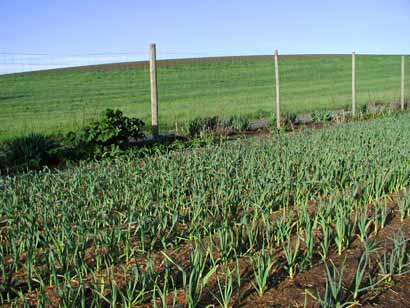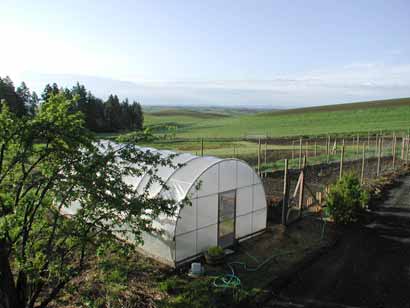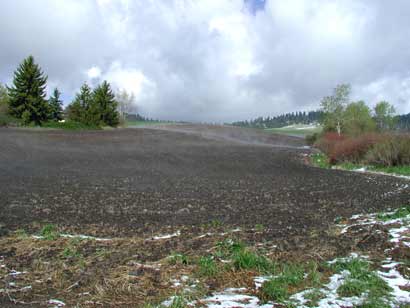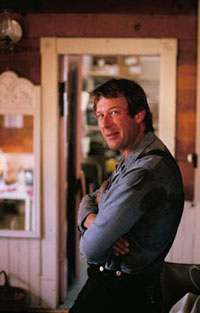
For generations uncounted, members of the Nez Perce Tribe wintered
in the warm shelter of the Snake River canyons and then spent their
summers gathering food on the upland prairies in what is now northern
Idaho and northeastern Oregon. One of their annual migration trails
left the river near what is now Lewiston, Idaho, and climbed almost
2,000 feet in elevation to the fertile grassland region along the
Idaho-Washington border that today is known as the Palouse.
During the summers, the Nez Perce hunted deer in the forests and
gathered the starchy roots of the blue-flowering camas in the moist
meadowlands. One of their favored camas grounds was located at what
is now the town of Moscow, Idaho. The trail from those fields to
the river canyon first crossed over the low hill southeast of Moscow
called Paradise Ridge, then aimed south to the river.
In the late 19th century, settlers came to those fertile
fields with plows and wagons. These homesteaders followed that same
Nez Perce Trail south from Moscow. Eight miles from Moscow, nestled
among the rolling Palouse hills just on the other side of Paradise
Ridge, they built another community, a town they called Blaine.
The settlement became a stagecoach stop on the road built on the
original trail.

By 1925, Blaine
was a town with a church, school, stores and a dozen homes. That
was the year that Ivan Ogle, aged 15, arrived with his parents Ward
and Rhoda Ogle. They bought a 240-acre farm and set to work, harvesting
grain and hay, and building a house at the edge of the Blaine community.
In 1936, Ivan married Ruth Morton, his neighbor, and later took
over the family farm from his father.
Ivan and Ruth, who spent virtually all of their married lives together
in that same farmhouse, had four children. Nick, the youngest, was
born in 1950. By the time he was ten years old, Nick was driving
tractor, putting up hay, helping with equipment maintenance, and
doing his share to keep up with the work on the family farm. The
Ogles’ farm grew in 1962 to a total of 640 acres with the purchase
of 400 acres nearby.
In 1969, Nick graduated from Moscow High School, spent a few years
at the University of Idaho, and then moved to Boise where he married.
“My father said he was retiring in 1974,” Nick said.
“He told me that either I could come back and farm or he was
going to sell out. My brother and my sisters were not interested
in farming. So we came back.”

In a partnership
with his father that continues to this day, Nick took over the farm
and the 600 tillable acres planted annually in wheat, peas, barley,
and other crops. His parents stayed on the farm, remaining in the
same home. Following his divorce in 1989, Nick and his two sons,
Brian and Sam, continued to live about a mile from his parents’
farmhouse.
Then in 1990, Nick met his neighbor, MaryJane Butters, the woman
who bought the five-acre homestead adjacent to his farm.
“She was riding her bike down her driveway to the mailbox,
with her two kids in the bike trailer,” he recalled. “I
got down off the combine and introduced myself.”
Nick smiled shyly. “I picked flowers up on the ridge and left
them on her doorstep a couple of times. I guess there was a mutual
attraction. We started seeing more of each other. Then, we got married
in 1993.”
One thing they discovered during their courtship was a common belief
that farming should be done differently, that an alternative was
needed to conventional agriculture. MaryJane, the former environmental
activist, sought to wean farmers from pesticide dependency, and
Nick, the lifelong farmer, was searching for a way to bring stability
and financial independence back to the family farm.
They both recognized that if organic agriculture was to become
a realistic alternative, for Palouse area farmers or for anyone,
then someone needed to make it happen.

“There
really was no organic agriculture here on the Palouse,” Nick
explained. “I kept thinking: if people want organic food, why
don’t I give it to them? MaryJane had already begun Paradise Farm
Organics as a way to provide a market for organic products. She
is a visionary — she can take an idea and put wheels under it. We
kept making more prepared foods for sale and buying more organic
peas, lentils, beans and other products from local farmers. It just
kept snowballing.”
“And now, the business keeps growing as one thing leads to
another. But the goal is still to provide a place for organic farmers
to market their products.”
Juggling business and farm, Nick is a busy man. In the corporate
structure of Paradise Farm Organics, Nick is the vice-president
in charge of production. He supervises the crew responsible for
mixing, ordering, bagging and shipping. In his extra moments, he
runs the farm.
Part of the 600 acres are farmed organically, providing wheat,
hay, herbs and vegetables marketed by the company. The rest of the
land is leased to a neighbor and farmed conventionally. Nick is
converting all the land to organic production.
“What I have learned is that as an alternative to conventional
agriculture, organics is a way for family farms to prosper,” Nick said. “However, it is a long process to move from conventional
to organics — and very labor intensive. It will be my life’s work.
I accept that and I understand that. What all farmers who are interested
in making this shift need to realize is that this provides an opportunity
for those willing to take the risk. We need to remember that every
farm in the US was organic before 1946. In this country, we have
gone from the old-school to what is now called conventional agriculture
very quickly.”
 |
“I am committed to encouraging other farmers to grow good, clean, high quality, certified organic food. I want to preserve common sense and the joy of rural life.”
|
|
(c) 1995, Jim Richardson
|
In addition to his production work and his farm fields, Nick has
found time to serve his community in various volunteer positions.
From 1980 to 1992, he was a board member of the Inland Empire Pea
Growers Association, a growers’ cooperative. He joined the
board of directors for the Moscow Food Co-op in 1997 and served
as board chair from 1998 until 2000. During his tenure, the co-op
moved to a new location, doubling in size and doubling in sales.
Nick is also the president of the Blaine Community Association.
The association is dedicated to preserving both the history of the
Blaine community and their town’s original schoolhouse, which
still stands — surrounded now by fields, not homes and businesses.
“In 1937, the school closed, and the town was gone soon thereafter,”
Nick explained. “We’ve kept the schoolhouse, and offer
it now for weddings, dances, and parties. The schoolhouse keeps
alive memories of the town, the stagecoach, and the Nez Perce Trail
before that. Keeping Blaine alive preserves the rich history of
this land where I was born.”
– by Bill London
August 12, 2002
|
A place belongs forever to whoever claims it hardest, remembers it most obsessively, wrenches it from itself, shapes it, renders it, loves it so radically that he remakes it in his own image.
– Joan Didion
|
